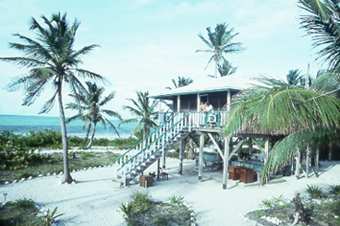
|

Middle Caye is one of four small coral islands that rim Glover's Reef, one of Belize's three atolls. The other atolls, Turneffe Island and Lighthouse Reef, lie off the northern coast of Belize, whereas Glover's Reef is considered to be part of the Stann Creek District in Belize's southern half. Belize's barrier reef is dotted with coral islands both along the edge of the reef and slightly to the leeward of the reef edge; the atolls, however, lie 7 to 20 miles to the west of the reef edge. The extent to which the ancient Maya utilized the islands of Belize's atolls is unknown; a report was published on some pottery found at Grand Bogue Point, on Turneffe Island (Euan MacKie, "Some Maya Pottery from Grand Bogue Point, Turneffe Islands, British Honduras," in Atoll Research Bulletin No. 95, pp. 131-135, 1963), but none of the atolls has yet been explored systematically. |
 |
The work I carried out on Ambergris Caye with David Pendergast from 1990 to 1993 (E. Graham and D.Pendergast, "Excavations at the Marco Gonzalez Site, Ambergris Cay, Belize, 1986," Journal of Field Archaeology 16(1):1-16, 1989) demonstrated that the Maya had a long history of occupation and use of Belize's offshore islands going back to at least 300 B.C. As a result I was curious to know if the Maya had the seafaring knowledge to make consistent and long-term use of the islands of the atolls. The Wildlife Conservation Fund, formerly the New York Zoological Society, had recently established a marine research station which we were invited to use on Middle Caye. This provided a good opportunity for us to carry out a preliminary survey. |
|
 |
|
We also recovered a range of Historic-period remains. Most of the material is 19th century in date and British or local in origin, but there is a small amount of late 18th century ceramic material as well as artifacts, such as ceramic moulds for glass floats and other as yet unidentified items, that are, not surprisingly, related to fishing and seafaring. We did not carry out excavations in 1997. Once we complete analysis of the recovered artifacts we would like to return to Middle Caye to carry out test excavations in the artifact-rich areas to determine whether any structural or other features remain from the historic or Maya occupations. The evidence from Grand Bogue Point and from Middle Caye together suggests strongly that the Maya used the islands of the atolls more than just casually, beginning quite early. We do not yet know whether the atoll locations were important only as fishing stations, or were used for longer-term occupation or even as trade depots of some sort. The last possibility seems unlikely given their distance from the mainland, but only future work can provide the answer. Our thanks to everyone on Middle Caye who provided their help and support, to Buddy Howell whom we did not meet but who helped with all our arrangements, and to Jacque Carter who helped to establish the research station and alerted us to its potential for increasing our archaeological knowledge of the Maya. |
|
|
| Archaeology in Belize |